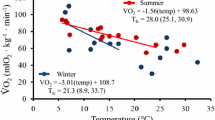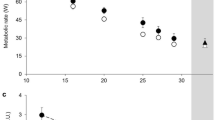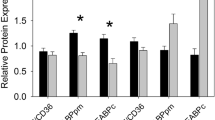Abstract
We investigated whether the relative contributions of body protein and lipid reserves differ according to the level of energy expenditure in fasting animals. Protein and lipid utilization was therefore quantified and compared in hedgehogs which fasted with shallow and deep hypothermia, i.e. by exposure at 5 or 20 °C ambient temperature. Body composition was determined for every 150-g decrease in mass throughout the experiment, allowing the calculation of regression lines between body mass (independent variable, x) and body composition (dependent variable, y: water, protein, neutral lipids, phospholipids and cholesterol). There were highly significant (P<0.001) linear decreases in all body components with decreasing body mass in both groups of hedgehogs. Neutral lipids were the main component of the total body mass loss (54%) in fasted animals with shallow and deep hypothermia, percentages of water (26–30%) and protein (10–11%) being lower, and those of phospholipid and cholesterol negligible (<0.5%). In spite of different levels in energy expenditure (2.54 and 1.07 W·kg-1 in shallow-and deep-hypothermal fasting hedgehogs, respectively), the energy sources were identical in both groups, neutral lipid being the main fuel (91–92%) and body protein accounting for the remainder (8–9%). Prolonged fasting with shallow and deep hypothermia were marked by low alaninemia and glycemia, while plasma free fatty acids and β-hydroxybutyrate were elevated. These data therefore indicate that the relative contribution of lipid and protein is similar during prolonged fasting with shallow and deep hypothermia, i.e. there is no specific effect of deep hypothermia on body fuel utilization. The tolerance of a much longer fast in deep-hypothermal hedgehogs can simply be attributed to the lower rates of lipid and protein utilization as a result of the lower level of energy expenditure.
Similar content being viewed by others
Abbreviations
- bm:
-
body mass
References
Barré H (1984) Metabolic and insulative changes in winter- and summer-acclimatized king penguin chicks. J Comp Physiol B 154:317–324
Bartlett GR (1959) Phosphorus assay in column chromatography. J Biol Chem 234:466–468
Bartness TJ, Milner R, Geloen A, Trayhurn P (1991) Effects of high fat diets on hibernation and adipose tissue in Turkish hamsters. J Comp Physiol B 161:451–459
Cahill GF, Marliss EB, Aoki TT (1970) Fat and nitrogen metabolism in fasting man. In: Jeanrenaud B, Hepp D (eds) Adipose tissue: regulation and metabolic functions. Academic Press, New York, pp 181–185
Castellini MA, Rea LD (1992) The biochemistry of natural fasting at its limits. Experientia 48:575–582
Cherel Y, Le Maho Y (1985) Five months of fasting in king penguin chicks: body mass loss and fuel metabolism. Am J Physiol 249 (Regul Integr Comp Physiol 18):R387–R392
Cherel Y, Ridoux V (1992) Prey species and nutritive value of food fed during summer to king penguin Aptenodytes patagonica chicks at Possession Island, Crozet Archipelago. Ibis 134:118–127
Cherel Y, Robin JP, Le Maho Y (1988) Physiology and biochemistry of long-term fasting in birds. Can J Zool 66:159–166
Cherel Y, Robin JP, Heitz A, Calgari C, Le Maho Y (1992) Relationships between lipid availability and protein utilization during prolonged fasting. J Comp Physiol B 162:305–313
Cherel Y, Fréby F, Gilles J, Robin JP (1993) Comparative fuel metabolism in gentoo and king penguins: adaptation to brief versus prolonged fasting. Polar Biol 13:263–269
Cherel Y, Gilles J, Handrich Y, Le Maho Y (1994) Nutrient reserve dynamics and energetics during long-term fasting in the king penguin (Aptenodytes patagonicus). J Zool (London) 234:1–12
Cranford JA (1978) Hibernation in the western jumping mouse (Zapus princeps). J Mamm 59:496–509
Florant GL, Nuttle LC, Mullinex DE, Rintoul DA (1990) Plasma and white adipose tissue lipid composition in marmots. Am J Physiol 258 (Regul Integr Comp Physiol 27):R1123–R1131
Folch J, Lees M, Sloane-Stanley GH (1957) A simple method for the isolation and purification of total lipids from animal tissues. J Biol Chem 226:497–509
Folk GE (1957) Twenty-four hour rhythms of mammals in a cold environment. Am Nat 91:153–166
Fowler PA, Racey PA (1990) Daily and seasonal cycles of body temperature and aspects of heterothermy in the hedgehog Erinaceus europaeus. J Comp Physiol B 160:299–307
Galster W, Morrison P (1976) Seasonal changes in body composition of the arctic ground squirrel, Citellus undulatus. Can J Zool 54:74–78
Goodman MN, Larsen PR, Kaplan MM, Aoki TT, Young VR, Ruderman NB (1980) Starvation in the rat. II. Effect of age and obesity on protein sparing and fuel metabolism. Am J Physiol 239 (Endocrinol Metab 2):E277–E286
Groscolas R (1990) Metabolic adaptations to fasting in emperor and king penguins. In: Davis LS, Darby JT (eds) Penguin biology. Academic Press, San Diego, pp 269–296
Groscolas R, Schreiber L, Morin F (1991) The use of tritiated water to determine protein and lipid utilization in fasting birds: a validation technique in incubating great-winged petrels, Pterodroma macroptera. Physiol Zool 64:1217–1233
Harper JF (1984) Peritz' F-test: basic program of a robust multiple comparison test for statistical analysis of all differences among group means. Comput Biol Med 14:437–445
Kates M (1972) Techniques of lipidology. North Holland, Amsterdam, pp 360–361
Kayser C (1961) The physiology of natural hibernation. Academic Press, Oxford
Krilowicz BL (1985) Ketone body metabolism in a ground squirrel during hibernation and fasting. Am J Physiol 249 (Regul Integr Comp Physiol 18):R462-R470
Kristoffersson R, Suomalainen P (1964) Studies on the physiology of the hibernating hedgehog. 2. Changes of body weight of hibernating and non-hibernating animals. Ann Acad Sci Fenn Ser A 76:1–11
Le Maho Y, Robin JP, Cherel Y (1988) Starvation as a treatment for obesity: the need to conserve body protein. News Physiol Sci 3:21–24
Maxwell RK, Thorkelson J, Rogers LL, Brander RB (1988) The field energetics of winter-dormant black bear (Ursus americanus) in northeastern Minnesota. Can J Zool 66:2095–2103
Morris P (1984) An estimate of the minimum body weight necessary for hedgehogs (Erinaceus europaeus) to survive hibernation. J Zool (London) 203:291–294
Nelson RA (1980) Protein and fat metabolism in hibernating bears. Fed Proc 39:2955–2958
Piersma T, Jukema J (1990) Budgeting the flight of a long-distance migrant: changes in nutrient reserve levels of bar-tailed godwits at successive spring staging sites. Ardea 78:315–337
Rauch JC, Behrisch HW (1981) Ketone bodies: a source of energy during hibernation. Can J Zool 59:754–760
Riedesel ML, Steffen JM (1980) Protein metabolism and urea recycling in rodent hibernators. Fed Proc 39:2959–2963
Robin JP, Cherel Y, Girard J, Géloen A, Le Maho Y (1987) Uric acid and urea in relation to protein catabolism in long-term fasting geese. J Comp Physiol B 157:491–499
Saboureau M (1986) Hibernation in the hedgehog: influence of external and internal factors. In: Heller HC et al. (eds) Living in the cold. Physiological and biochemical adaptations. Elsevier, New York, pp 253–263
Saboureau M, Castaing L, Boissin J (1984) Influence du taux plasmatique de testostérone et du jeûne sur les variations automnales et hivernales de l'activité motrice générale du Hérisson, Erinaceus europaeus L. CR Acad Sci Sér III 299:239–244
Saboureau M, Cherel Y, El Omari B, Le Maho Y (1991a) Contribution des protéines et des lipides à la dépense énergétique du Hérisson à jeun avec ou sans hibernation. Arch Int Physiol Biochim Biophys 99:A175
Saboureau M, Vignault MP, Ducamp JJ (1991b) L'hibernation chez le Hérisson (Erinaceus europaeus L.) dans son environnement naturel: étude par biotélémétrie des variations de la température corporelle. CR Acad Sci Paris Sér III 313:93–100
Schmidt-Nielsen K (1979) Animal physiology: adaptation and environment, 2nd edn. Cambridge University Press, Cambridge
Tähti H (1978) Seasonal differences in O2 consumption and respiratory quotient in a hibernator (Erinaceus europaeus L.). Ann Zool Fenn 15:69–75
Willis JS (1982) Intermediary metabolism in hibernation. In: Lyman CP et al. (eds) Hibernation and torpor in mammals and birds. Academic Press, New York
Yacoe ME (1983) Protein metabolism in the pectoralis muscle and liver of hibernating bats, Eptesicus fuscus. J Comp Physiol B 152:137–144
Author information
Authors and Affiliations
Rights and permissions
About this article
Cite this article
Cherel, Y., El Omari, B., Le Maho, Y. et al. Protein and lipid utilization during fasting with shallow and deep hypothermia in the European hedgehog (Erinaceus europaeus). J Comp Physiol B 164, 653–658 (1995). https://doi.org/10.1007/BF00389807
Accepted:
Issue Date:
DOI: https://doi.org/10.1007/BF00389807




